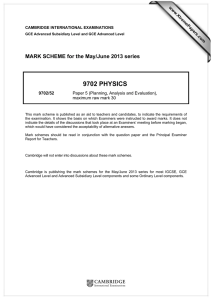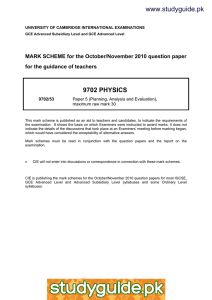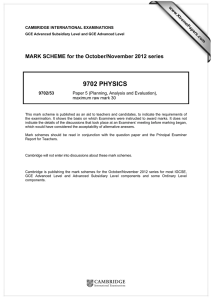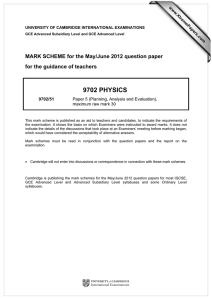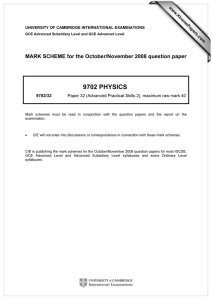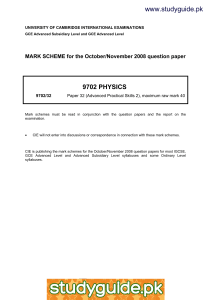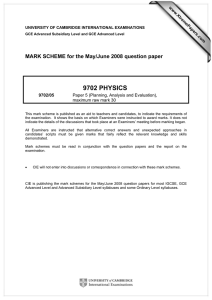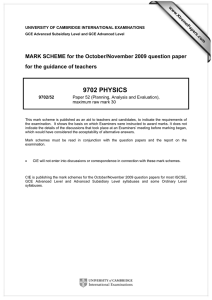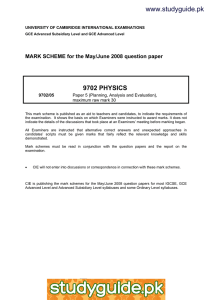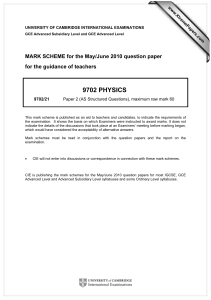9702 PHYSICS MARK SCHEME for the October/November 2010 question paper
advertisement
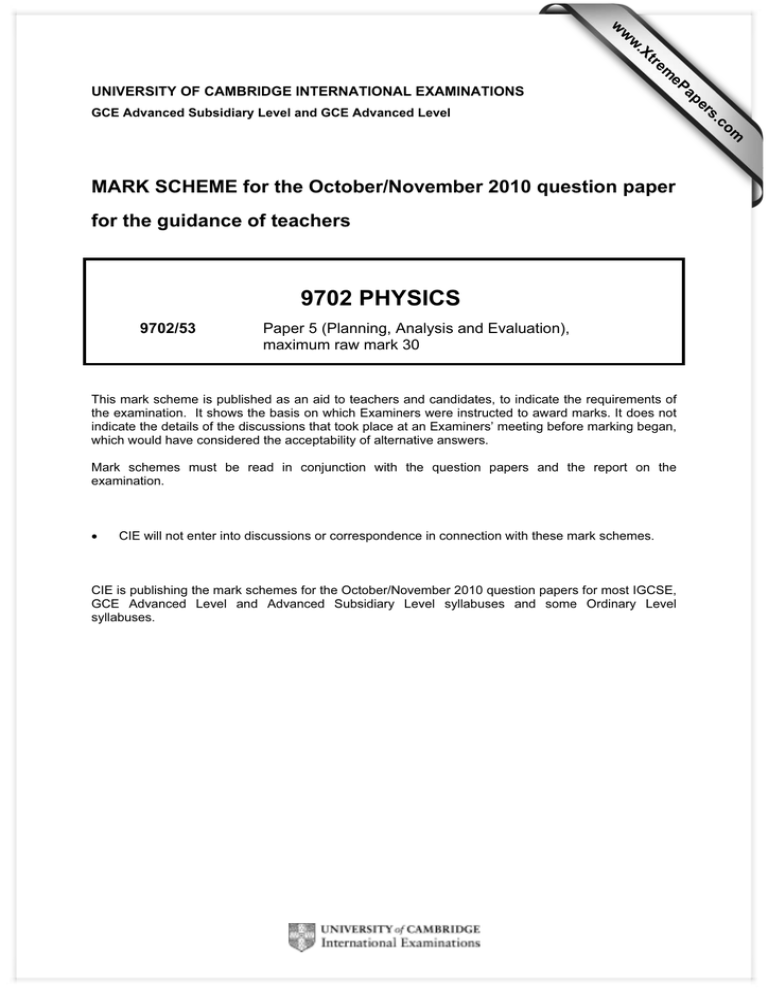
w w ap eP m e tr .X w UNIVERSITY OF CAMBRIDGE INTERNATIONAL EXAMINATIONS for the guidance of teachers 9702 PHYSICS 9702/53 Paper 5 (Planning, Analysis and Evaluation), maximum raw mark 30 This mark scheme is published as an aid to teachers and candidates, to indicate the requirements of the examination. It shows the basis on which Examiners were instructed to award marks. It does not indicate the details of the discussions that took place at an Examiners’ meeting before marking began, which would have considered the acceptability of alternative answers. Mark schemes must be read in conjunction with the question papers and the report on the examination. • CIE will not enter into discussions or correspondence in connection with these mark schemes. CIE is publishing the mark schemes for the October/November 2010 question papers for most IGCSE, GCE Advanced Level and Advanced Subsidiary Level syllabuses and some Ordinary Level syllabuses. om .c MARK SCHEME for the October/November 2010 question paper s er GCE Advanced Subsidiary Level and GCE Advanced Level Page 2 1 Mark Scheme: Teachers’ version GCE A/AS LEVEL – October/November 2010 Syllabus 9702 Paper 53 Planning (15 marks) Defining the problem (3 marks) P1 c, d or A is the independent variable and R is the dependent variable or vary c, d or A and measure R. [1] P2 If c varied then (t and) d or A kept constant, if d varied then (t and) c or A kept constant, if A varied then c or d kept constant. [1] P3 Keep temperature constant. [1] Methods of data collection (5 marks) M1 Circuit diagram to measure resistance. [1] M2 Use micrometer screw gauge to measure d or t. (Allow digital or vernier callipers) [1] M3 Measure c with a ruler/metre rule. [1] M4 Method of making contact with the strip e.g. use electrodes of at least same dimension as c or d or t or conducting paint methods. Do not allow crocodile clips, unless it is clear that the whole area of the end of the strip is covered. [1] M5 Method to determine resistance. [1] Method of analysis (2 marks) A1 Plot a graph of R against c, 1/d or 1/A depending on orientation. Other alternatives possible, e.g. R against 1/c depending on orientation [1] A2 Must be consistent with A1: ρ = A × gradient or t × gradient/c [1] Other alternatives possible, e.g. ρ = d × gradient/t Safety considerations (1 mark) S1 Reference sharp edges or cutting metals, e.g. wear gloves. Additional detail (4 marks) D1/2/3/4 Relevant points might include 1. Insulate aluminium strip 2. Take many readings of t or d and average 3. Use a protective resistor/circuit designed to reduce current 4. Rearrange equation to determine graph using c, d and t or A 5. Determine typical resistance of aluminium strip 6. Likely meter range of ammeter/voltmeter/ohmmeter 7. Detail on cutting strip e.g. mark using set square [1] [4] Do not allow vague computer methods. [Total: 15] © UCLES 2010 Page 3 2 Mark Scheme: Teachers’ version GCE A/AS LEVEL – October/November 2010 Syllabus 9702 Paper 53 Analysis, conclusions and evaluation (15 marks) Part Mark (a) A1 (b) T1 T2 (c) (i) (ii) (iii) (d) (i) Expected Answer − Additional Guidance t Must be negative. Allow − C 150 1.28 or 1.281 100 1.61 or 1.609 66.7 1.86 or 1.856 50.0 1.97 or 1.974 33.3 2.08 or 2.079 15 C . T1 for 1/R column – ignore sf and rounding errors T2 for ln (V/V) column – must be values given A mixture is allowed U1 From ± 0.05 or ± 0.06 to ± 0.02 or ± 0.03 Allow more than one significant figure. G1 Five points plotted correctly Must be within half a small square; penalise ≥ half a small square. Ecf allowed from table. Penalise ‘blobs’ ≥ half a small square. U2 Error bars in ln(V/V) plotted correctly. All plots to have error bars; penalise ≥ half a small square. Check first and last point. Must be accurate within half a small square. G2 Line of best fit If points are plotted correctly then upper end of line should pass between (20, 2.16) and (20, 2.18) and lower end of line should pass between (160, 1.20) and (160, 1.225). Allow ecf from points plotted incorrectly – examiner judgement. G3 Worst acceptable straight line. Steepest or shallowest possible line that passes through all the error bars. Line should be clearly labelled or dashed. Should pass from top of top error bar to bottom of bottom error bar or bottom of top error bar to top of bottom error bar. Mark scored only if all error bars are plotted. C1 Gradient of best fit line Must be negative The triangle used should be at least half the length of the drawn line. Check the read offs. Work to half a small square; penalise ≥ half a small square. Do not penalise POT. U3 Uncertainty in gradient Method of determining absolute uncertainty. Difference in worst gradient and gradient. C2 C = –15/gradient Gradient must be used. Allow ecf from (c)(iii). Do not penalise POT. C3 2.14 × 10–3 F to 2.24 × 10–3 F and to 2 or 3 sf Must be in range – penalise POT. Allow equivalent unit including s Ω–1, C V–1, A s V–1 © UCLES 2010 Page 4 (ii) (e) Mark Scheme: Teachers’ version GCE A/AS LEVEL – October/November 2010 Syllabus 9702 Paper 53 U4 Determines % uncertainty in C Uses worst gradient or worst calculated C value. Do not check calculation. C4 Determines R correctly Expect to see an answer about 3000 Ω. R = 6.514/candidate’s C; allow ecf from (d)(i) U5 Determines absolute uncertainty Determines worst value of R or (d)(ii) × R [Total: 15] Uncertainties in Question 2 (c) (iii) Gradient [U3] 1. Uncertainty = gradient of line of best fit – gradient of worst acceptable line 2. Uncertainty = ½ (steepest worst line gradient – shallowest worst line gradient) (d) (ii) [U4] 1. Works out worst C then determines % uncertainty 2. Works out percentage uncertainty in gradient (e) [U5] 1. Works out worst R then determines difference 2. ∆gradient ∆C R = ∆R = R C gradient © UCLES 2010

